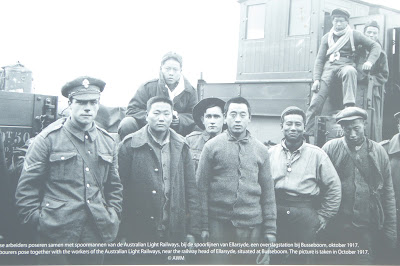 |
| Chinese Labour Corps Memorial Busseboom IJ |
The Chinese Memorial at Busseboom is the only memorial that commemorates the part played by 140,000 Chinese Labourers employed by the British and French during the Great War. Adjacent is another memorial to 13 Chinese labourers killed in a German air raid on 15th November 1917 which overlooks the former cemetery where they were buried.
 |
| Chinese Labourers Memorial Busseboom |
The manpower requirement for the movement all the materiel required to sustain the war effort (ammunition, combat supplies, food) on top of the troops required for combat produced an acute manpower shortage. As the British formulated their plans for 1917 it was apparent they needed additional manpower resources. In September 1916 a scheme to recruit Chinese labourers was initiated. China was a neutral country in WW1, so recruitment was done through a British leased territory, Wei-Hai-Wei, on the NE coast of China. France had instituted a similar scheme in May 1916.
 |
| Chinese workers being recruited in Wei-Hai-Wei |
The first contingent of the Chinese Labour Corps (CLC) consisting of 1,806 Chinese, six British officers and a Medical Officer sailed from Wei-Hai-Wei on 18th January 1917. They arrived in Le Havre 19th April 1917, a journey taking three months. The desire to shorten the journey time and the loss of 500 Chinese labourers when the SS Athos torpedoed, lead to the journey being re-routed through Canada. The journey would see the Chinamen sail to Vancouver, cross Canada by train to Halifax, Nova Scotia, then across the Atlantic to Liverpool or Plymouth in the UK. Another train journey to Folkstone then onward by ship to Noyellessur-Mer in France.
 |
| Chinese labourers routes from China to France |
The labourers were organised into Companies consisting of a headquarters and four platoons, each having 2 sections. Each company had between 470 and 490 Chinese labourers with British officers and NCO's. The CLC Companies were employed at ports and on lines of communication, some were allocated to Army's. Skilled Chinese workers served in maintenance depots, whilst some were employed as interpreters.
 |
| Chinese Labour Corps Badge |
 |
| Chinese Camp Mount Kemmel near Ypres |
 |
| Chinese Labourers working in ammo depot |
 |
| Chinese Labourers working on light railway Busseboom |
 |
| Chinese Labourer with Belgian child |
When America joined the war in April 1917, the priority for shipping was the movement of troops, consequently the supply of Chinese labourers diminished. By the signing of the Armistice in November 1918 there were 195 CLC Companies, with around 95,000 labourers.
After the war, the Chinese labourers began to be repatriated. Their work continued after the War, the Chinese re-burying casualties and filling in trenches. The last repatriation was in September 1920.
------o------
South China Morning
Post
The forgotten army
of the first world war
How
Chinese labourers helped shape Europe
------o------
The Chinese Labour Corps memorials were unveiled in November 1917 on the occasion of the centenary of Chinese Labourers killed in a German air raid. The memorial was imitated and paid for by the Chinese Embassy in Belgium.
------o------
The memorial to the Chinese Labour Corps features a bronze statue of 3 figures showing the type of work in which the Chinese Labourers were employed; entrenching, ammunition handling, casualty movement .
 |
| Chinese Labour Corps Memorial Busseboom |
 |
Chinese Labour Corps Memorial Busseboom
Entrenching
|
 |
Chinese Labour Corps Memorial Busseboom
Ammunition handling
|
 |
Chinese Labour Corps Memorial Busseboom
Stretcher Bearer
|
------o------
 |
| Roobeaertbeek Busseboom |
The memorial features a Chinese Labourer carrying a shell with a plaque bearing the names of those lost. The memorial has been exhibited in various locations, including Beijing, before finally being permanently based at Bussseboom.
 |
| Chinese Labourers Memorial |
 |
Chinese Labourers Memorial
|
KUO YU HIS Labourer 28996
LAN SHU THE Labourer 28995
LI CHI MAO Labourer 29009
LI HSI SHUN Labourer 29073
LIU PING KUEI Labourer 29038
LIU WAN CHI Labourer 29147
LUAN CHENG TSENG Labourer 29149
MA HSIAO LIN Labourer 28957
SHAO CHEN CHIANG Labourer 29501
WANG CHANG HO Labourer 29992
WANG CHANG HO Labourer 29135
WANG YUNG CHUN Labourer 29029
------0------
LAN SHU THE Labourer 28995
LI CHI MAO Labourer 29009
LI HSI SHUN Labourer 29073
LIU PING KUEI Labourer 29038
LIU WAN CHI Labourer 29147
LUAN CHENG TSENG Labourer 29149
MA HSIAO LIN Labourer 28957
SHAO CHEN CHIANG Labourer 29501
WANG CHANG HO Labourer 29992
WANG CHANG HO Labourer 29135
WANG YUNG CHUN Labourer 29029
------0------
In recognition of their service in the Great War, those who served with the Chinese Labour Corps were awarded the British War Medal. Sadly, the prejudices of that period meant that it was a bronze medal, not the silver medal awarded to British Empire Troops.
 |
Chinese Labour Corps
British War Medal
|












.JPG)
















